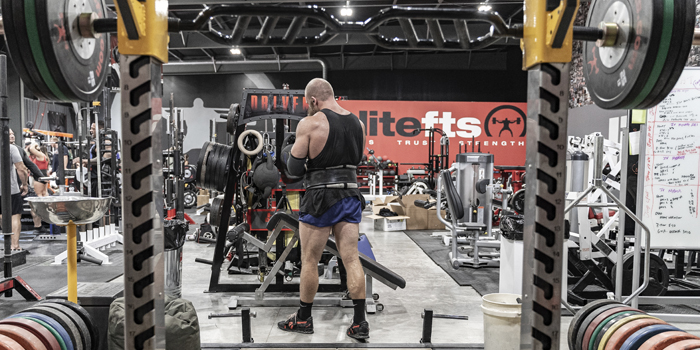
The first thing we must do here is separate the concepts of pain and injury. Sure, if there is damage to the body—a cut, a bruise, a break, or a tear—it'll probably hurt, but just because something hurts does not always mean it is broken. When you feel pain, it isn't happening where it hurts. The experience of pain is like any other sensation. Pain occurs at the level of the brain as a result of about a bazillion and a half signals coming from both the body and within the brain itself. Those bazillion and a half signals are going to interact, and the result will be your sense of how your body feels. Pain and sensation are all in your head.
It's often said that pain is multifactorial—an acknowledgment of the mess of influences that can contribute to your brain going, "Ow, this hurts." Previous injury and an expectation of pain with movement can be a big one—you hurt yourself once, maybe you'll hurt yourself again. Social priming can be another, as in someone is told repeatedly that deadlifts are bad for their back, and they begin to expect to get hurt. Sleep, stress, fatigue, illness, emotional state, and even the subconscious mind can play a role in perceiving pain. And, if something is damaged, it can hurt.
"Yeah, but Seth, I don't care what pain is or how it happens; I just want my knee to stop hurting whenever I squat."
OK, OK, we'll get there. With the nagging type of joint ouchies that are going to happen in the gym, it is unlikely that the root of the pain is structural damage. Even with pain that has persisted following a tear or a pop, the structures will heal given enough time. If you aren't in the acute stage of injury following traumatic insult, it's most likely that the pain you are experiencing is the result of hypersensitivity. You aren't hurting because of damage; you are hurting because the brain's alarm system is cranked up to eleven—normal levels of stimulus are being registered as dangerous.
*Insert disclaimer, so someone doesn't try to train through some sort of literal knee cancer and sue my ass.*
We know that pain is all in the head, but that doesn't mean we should ignore it and proceed with our day. After you go and get yourself checked out by a professional, we can rule out something more sinister as the cause of your pain. Now, what can we do about it?
RELATED: Can Training Be Protective Against Injury?
First, we need to address the psychosocial factors that could be influencing pain. Second, we need to understand that training with some pain is safe; although pain should be acknowledged, it doesn't need to cause stress. Third, we need to begin to restore a normal level of sensitivity to motion and force. Fourth, we need to know when we can get back to our normal training.
The Other Influences on Pain
Pain is multifactorial. There is a multitude of factors contributing to pain. If we are managing pain, we need to ask how the elements outside of our structure, outside of ourselves, and outside of our biology can influence our perception of pain.
The biopsychosocial model of pain seeks to consider the host of factors influencing pain and consider how they can potentially influence each other. It's not just our bodies, it's not just our minds, and it's not just societal norms that can contribute to pain. If we are going to deal with pain, why would we only look at it from the side of our body?
Are you chronically underslept? Do you feel anxious at the gym? Does your nutrition suck? Do you have a high level of day-to-day stress? Are you sick? Are you angry? Are you sad? Is grandma always telling you that powerlifting is a one-way ticket to snap city?
If you answered yes to any of those (or about 10,000 other similar questions), they could be contributing to an increased perception of pain. If we want to positively influence pain, we need to control and address psychosocial factors where possible. Working on getting more sleep, improving your nutrition, and seeking help to manage anxiety and stress are all things you can do to reduce the pain you are experiencing. Even if they don't improve your pain, working on those areas will improve other parts of your life. Work on them.
It might be tougher to get grandma to stop nagging you about powerlifting, but remember that grandma doesn't even lift, and she doesn't know what she's talking about.
Is It OK to Train With Some Pain?
Absolutely. As we mentioned above, pain DOES NOT need to equate to broken. If we rule out more sinister visceral causes of pain and know that an athlete isn't in the acute stage of injury following a significant trauma, it becomes acceptable to load painful body parts. (Even following major injury or surgery, painful body parts should be loaded to some degree, but that is a discussion meant for a rehabilitation article).
From experience, you guys probably know that pain often gets worse when you ignore it and train through it. Why is that? Most likely, it's not because you are causing more damage. Pain is an alarm system; it is your brain trying to say, "Hey guys, we should be cautious here." If you continuously ignore that alarm, your brain is going to try harder and harder to get you to use some caution. Pretty soon, a low-grade stimulus like getting off the toilet can hurt like a long series of explicatives. That is hypersensitivity, and that is what we want to avoid when we are training with pain.
How can we avoid jacking up our sensitivity to movement? If pain is an alarm telling you to use some caution, LISTEN TO IT. Acknowledge the pain and proceed with caution. By acknowledging pain, feeling it, listening to it, and understanding its purpose, we can find ways to train without making our bodies feel worse. We can even begin to feel better as we go.
In my practice, I will usually tell my lifters that if they're feeling a two to three out of ten on the pain scale to proceed as normal as long as their pain level does not increase as they go. I talk them through how they'll know a two or three out of ten isn't crazy, how they know it's not making things worse, and how the recommendation to not exceed that level is less about preventing structural damage and more about not causing further hypersensitization to movement. The more OK you become with that two or three out of ten, the safer that two or three will be perceived, and eventually, you won't even register it as pain. It might not happen overnight, but it will happen.
What If It's Impossible to Train Normally Without Severe Pain?
If you can't come close to your normal training without exceeding that two or three out of ten, that is when we can begin to modify what we are doing in the gym. We can adjust the load and take weight off the bar allowing you to still get some work in. We can modify the range of motion to avoid specific painful parts of the movement. We can modify exercise selection to reduce the stress on certain areas of the body.
The critical thing to note with those modifications is that they are temporary solutions. If you want to get back to training at full capacity, you need to bridge the gap back gradually. How fast should you bridge that gap? My usual recommendation is to make progress at whatever rate allows them not to exceed that two to three out of ten range with the people I'm working with.
We can also get creative with exercise selection to begin to expose tissues and joints where they may be hypersensitive. The lowest grade of stimulus would be to stretch statically into the painful range of motion, with the goal being to increase the range you can access within that two to three out of ten level. Once a static stretch becomes tolerable, you can begin contracting isometrically into the stretch to increase the amount of force you are exposed to in that range. Once you feel comfortable contracting isometrically in that range, you can begin to move dynamically through it. By the time you can move dynamically through that range, you should feel a whole lot better when performing the movement that initially hurt.
For someone experiencing knee pain in the bottom of their squat, a sequence they could progress through might look like:
- Kneel on the floor (put a mat down if necessary) and attempt to sit on your heels to expose the knee to flexion and the quad to length. You may need to hold onto something for support at first.
- Once you can sit on your heels relatively comfortably, you can begin to contract your quads lightly to increase the amount of tension in the system.
- Once isometric contraction is relatively comfortable, you can begin to move in and out of the end range. You can progress that to full kneeling squats or even full reverse Nordics.
How Do We Know When We Are Good to Go?
When is it time to throw caution to the wind? When you no longer anticipate that you will experience pain before performing a movement. The anticipation of pain can influence the perception of pain itself. When that anticipation is gone, it is a very positive sign that you're well on your way to being able to train at your full capacity again.
Getting out of pain is an adaptation. If a stimulus is perceived as painful, we need to adapt to it so that it is no longer the cause of alarm. Accepting a small degree of pain, not panicking when we feel pain, and understanding that some pain doesn't mean danger will be a large part of that adaptation. As we mentioned above, the more you can do in that two to three out of ten range and the safer you feel doing it, the less severe your perception of pain will become. Eventually, there will be a eureka moment when you won't perceive any pain at all, despite its anticipation. Continue to bridge the gap back to normal intelligently, and soon enough, the expectation of pain will disappear. (That doesn't mean you're free to toss 120% of your squat max on the bar and expect things to go well).
Pain is highly nuanced, and its complexities extend far beyond the scope of this article. But, we can still do something about pain without understanding every one of its complexities. If we know that factors aside from structure can influence pain, we can begin to reduce the perception of pain before we even look at tissue or movement. If we know pain does not always mean something is broken, we can feel safer when we experience pain. If we learn that it is safe to train and move with pain, we can progress towards moving and training without pain.
Seth Albersworth is a powerlifter with experience in and out of gear. His best totals are 2105 pounds raw and 2408 pounds multi-ply. Seth has completed his bachelor's degree in kinesiology from the University of Calgary and recently graduated from Palmer College of Chiropractic's Florida Campus. He's in the process of acquiring licensure as a Doctor of Chiropractic.










